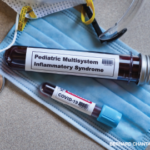The ACR has released clinical guidance documents for pediatric patients with rheumatic disease in the context of the COVID-19 pandemic, including one for multi-system inflammatory syndrome in children (MIS-C). Jay Mehta, MD, MS, an attending physician in the Division of Rheumatology and director of the Pediatric Rheumatology Fellowship at the Children’s Hospital of Philadelphia (CHOP), chaired the ACR COVID-19 Pediatric Rheumatology Clinical Guidance Task Force, charged with developing the guidance.
The majority of serious and life-threatening outcomes of COVID-19 have occurred in adults, and in April the ACR released clinical guidance for the care of adult patients with rheumatic diseases during the pandemic. In the earlier stages of the pandemic, it appeared children were less likely to develop severe manifestations of SARS CoV-2. But as case reports accumulated of children exhibiting multi-system inflammatory syndromes with features similar to Kawasaki disease, the ACR decided to develop pediatric-focused clinical guidance as well, Dr. Mehta says. It made sense, he reasoned, to set up two task forces: one to address clinical guidance for pediatric patients with rheumatic disease, and another to provide guidance regarding children with multi-system inflammatory syndrome associated with SARS-CoV-2 and hyperinflammation in COVID-19.
Dr. Mehta and his two lead task force physicians recently shared the processes they followed for their work, which took place over a very short period of time, from mid-May to mid-June. Characterized by even-handed and reassuring language, both guidance documents were submitted to, and accepted by, Arthritis & Rheumatology. In addition, Dr. Mehta notes, the guidance documents are very much living documents and will be revisited and updated as evidence evolves.
Editor’s note: The ACR hosted a virtual town hall for the rheumatology community on Aug. 11 to review the recommendations. Dr. Mehta and David Karp, MD, PhD, ACR president elect, served as co-moderators for the discussion.
Evaluating Evidence
 Dawn M. Wahezi, MD, associate professor in the Department of Pediatrics and division chief in Pediatric Rheumatology, Children’s Hospital at Montefiore, The Bronx, N.Y., was selected to lead the ACR COVID-19 Pediatric Rheumatology Clinical Guidance Task Force. The Bronx was one of the first pandemic hot spots in the U.S., and Dr. Wahezi was chosen in part due to her direct experience with the virus.
Dawn M. Wahezi, MD, associate professor in the Department of Pediatrics and division chief in Pediatric Rheumatology, Children’s Hospital at Montefiore, The Bronx, N.Y., was selected to lead the ACR COVID-19 Pediatric Rheumatology Clinical Guidance Task Force. The Bronx was one of the first pandemic hot spots in the U.S., and Dr. Wahezi was chosen in part due to her direct experience with the virus.
Following her initial conversation with Dr. Mehta, Dr. Wahezi recalls that “everything happened fairly quickly.” When inviting possible task force participants, she says, “we intentionally included pediatric rheumatologists from across the country [with varied] expertise and from areas with [varying] prevalence of COVID-19.”
She and Dr. Mehta drafted general, clinical questions based on issues they and other providers had encountered with patients, families and other providers. Evidence to date is limited, she notes, so they also looked to the Centers for Disease Control & Prevention (CDC) and other online sources for clinical questions to address.
Those questions were proposed to task force members—comprising seven pediatric rheumatologists, two pediatric infectious disease physicians, one adult rheumatologist and one pediatric nurse practitioner—during a webinar on May 21. Participants voted anonymously on the initial questions using a 1 to 9 rating scale (1 = disagree; 9 = agree). The statements were refined through two more rounds of voting until consensus was reached. To be approved and included as a guidance statement, the votes were required to fall into the highest third for agreement, representing moderate to high levels of consensus.
Management Recommendations
 The guidance includes general recommendations, such as counseling patients and their families about public health protocols (e.g., hand washing, social distancing, wearing masks) to avoid potential exposure to SARS-CoV-2. Noting that families may be reluctant to bring their children to clinics for regular visits, Dr. Wahezi and her colleagues recommend the use of telemedicine to ensure continued access to care. The recommendations emphasize that it is equally important for physicians to continue non-rheumatic care, such as regular flu vaccinations and in-person ophthalmologic examinations if patients have a history of uveitis or are at high risk for the development of uveitis.
The guidance includes general recommendations, such as counseling patients and their families about public health protocols (e.g., hand washing, social distancing, wearing masks) to avoid potential exposure to SARS-CoV-2. Noting that families may be reluctant to bring their children to clinics for regular visits, Dr. Wahezi and her colleagues recommend the use of telemedicine to ensure continued access to care. The recommendations emphasize that it is equally important for physicians to continue non-rheumatic care, such as regular flu vaccinations and in-person ophthalmologic examinations if patients have a history of uveitis or are at high risk for the development of uveitis.
Dr. Mehta adds that during the first few weeks of the pandemic, he and his colleagues were worried their patients on immunosuppression would get very sick and require hospitalization. Although that has not happened, treatment decisions must be individualized for each patient and family, he says, noting “there’s a balance between keeping them safe and keeping them mentally healthy.” The guidance reminds providers that children and caregivers of children with pediatric rheumatic disease could be at risk of anxiety and depression due to the quarantine and other events surrounding COVID-19. Assessments for these risks should be conducted during regular visits.
Ongoing Treatment
The document also addresses ongoing treatment recommendations. For pediatric patients with rheumatic disease who have not been exposed to or infected with SARS-CoV-2, regular medication regimens should be continued, or new ones initiated, to control underlying disease. For those with stable disease who may be on stable doses of biologic or traditional synthetic disease-modifying anti-rheumatic drugs, extending laboratory testing intervals to assess for medication toxicity can be considered to reduce the risk of exposure to COVID-19.
 For pediatric patients who have close or household exposure to COVID-19, the task force had generally high levels of consensus regarding glucocorticoids. Initiation of high-dose oral or intravenous (IV) glucocorticoids should be delayed by one to two weeks, if safe, only for those patients whose rheumatic disease is non-life or organ threatening. With life- or organ-threatening manifestations, high-dose oral or IV glucocorticoids should not be delayed. Finally, the guidance stipulates specific treatment options for patients with asymptomatic or confirmed symptomatic COVID-19 infection.
For pediatric patients who have close or household exposure to COVID-19, the task force had generally high levels of consensus regarding glucocorticoids. Initiation of high-dose oral or intravenous (IV) glucocorticoids should be delayed by one to two weeks, if safe, only for those patients whose rheumatic disease is non-life or organ threatening. With life- or organ-threatening manifestations, high-dose oral or IV glucocorticoids should not be delayed. Finally, the guidance stipulates specific treatment options for patients with asymptomatic or confirmed symptomatic COVID-19 infection.
In The Bronx, Dr. Wahezi and her colleagues noted high levels of anxiety among families and providers. Nevertheless, many pediatric patients with rheumatic disease were not adversely affected by the pandemic. She sees addressing the fear and anxiety surrounding the pandemic as one of the main goals for the clinical guidance. In writing the guidance, she says, “We really wanted to drive home the message that controlling patients’ underlying disease is the most important goal, both to prevent long-term consequences related to their rheumatic disease and for reducing chances of infection.”
MIS-C
Since the beginning of the COVID-19 pandemic, the majority of serious and life-threatening outcomes have occurred in adults. But in late April, clinicians in the U.K. reported a cluster of previously healthy children who presented with cardiovascular shock, fever and hyperinflammation. On May 14, the CDC issued a national health advisory to report cases meeting the criteria for multi-system inflammatory syndrome in children.
Dr. Mehta realized the recommendations for MIS-C would differ from general recommendations targeted to SARS-CoV-2-exposed children with rheumatic disease who did not exhibit inflammatory syndromes and that specific diagnostic pathways could provide better guidance for clinicians. He helped convene a second task force, which in less than a month has now prepared a clinical guidance document specific for MIS-C associated with SARS-CoV-2 and hyperinflammation in COVID-19.
Lauren Henderson, MD, MMSc, an attending physician at Boston Children’s Hospital and assistant professor of pediatrics, Harvard Medical School, Boston, was chosen to lead the MIS-C task force, because she has experience developing treatment guidelines for children with hyperinflammatory syndromes and had seen numerous children with MIS-C.
The multidisciplinary task force included nine pediatric rheumatologists, two adult rheumatologists, two pediatric cardiologists, two pediatric infectious disease specialists and one pediatric critical care physician. During an initial webinar on May 22, the participants divided into four work groups to address different topic areas, such as the diagnostic evaluation of MIS-C, cardiac management and the role for immunomodulatory treatment. Each work group took a week to gather data for its evidence reports and to develop preliminary statements or recommendations. Those statements were submitted to the group at large for voting.
Similar to the general pediatric task force, the MIS-C task force built consensus through a modified Delphi process involving two rounds of anonymous voting and two webinars for discussion of anonymous voting results. A 9-point scale was used to determine the appropriateness of guidance statements, with 1 = inappropriate and
9 = appropriate.
MIS-C Distinct from Kawasaki Disease
Dr. Mehta notes that MIS-C case definitions from the CDC and the World Health Organization were “very broad, because they were designed for reporting cases rather than diagnostic purposes.” So the MIS-C task force relied on many sources of evidence and clinical pathways from several institutions, including the CHOP MIS-C clinical pathway, to develop their guidance.
As many early cases of MIS-C appeared, reports noted the clinical features closely resembled those seen with Kawasaki disease. Overlapping features include fever; conjunctival injection; oropharyngeal symptoms, such as red or cracked lips and strawberry tongue; rash; and cervical lymphadenopathy. The clinical guidance document specifies the ways in which MIS-C cases associated with SARS-CoV-2 differ from Kawasaki disease. For example, MIS-C patients exhibit a broader age range, and Kawasaki disease patients tend to be younger. MIS-C patients are more likely to display cardiac dysfunction, to have prominent gastrointestinal and neurologic symptoms, and to present in shock.
Dr. Henderson also points out that Kawasaki disease is most common in those of East Asian descent, while cases of MIS-C are more common in patients of Afro-Caribbean and possibly Hispanic descent. “There may be biologic factors that explain this, or it may be due to socioeconomic factors and thus greater exposure to SARS-CoV-2,” she says. More research is needed to supply answers to these observed patterns.
A Step-Wise Approach
The task force reiterated that the majority of children with COVID-19 have mild symptoms and excellent outcomes. In fact, the group achieved consensus on outpatient evaluation for children with stable vital signs, provided physicians ensure close follow-up. However, MIS-C patients who develop additional symptoms, such as tachycardia, respiratory distress, evidence of mild renal or hepatic injury or other abnormal laboratory findings, should be considered for hospital admission. The guidance document includes a tiered diagnostic workup to aid in staging these patients, says Dr. Mehta.
Patients admitted to the hospital should be evaluated by specialists with expertise in MIS-C and managed by a multidisciplinary team, Dr. Henderson emphasized. The guidance document supplies specific advice regarding cardiac management. Moderate to high consensus was achieved on most of the directives regarding cardiac imaging intervals and what each should include. For example, a high measure of consensus was achieved for echocardiograms to be conducted at diagnosis and during clinical follow-up to evaluate ventricular/valvular function, pericardial effusion and coronary artery dimensions with measurements indexed to body surface area using z-scores.
The document also includes guidance regarding immunomodulatory and anticoagulation treatment in MIS-C and when and how biologics may be introduced. MIS-C treatment may include low- to moderate-dose glucocorticoids, or high-dose, pulse glucocorticoids via IV in patients with life-threatening complications, such as shock. Specifics on timing, dosage and testing are included.
Key Messages Emphasized
Dr. Henderson was on service at Boston Children’s Hospital during the first wave of East Coast pandemic cases. “We saw quite a lot of MIS-C patients, and I cared for them on the week that we were the busiest,” she recalls. She and her colleagues from Boston Children’s have developed a manuscript summarizing their experience with more than 30 MIS-C patients. “Fortunately,” she says, “the patients all did very well and got better fairly quickly.” This is a message that’s also embedded in the guidance document: The vast majority of children with COVID-19 present with mild symptoms, and MIS-C remains a rare complication.
However, she adds, the field is evolving and our knowledge about MIS-C will change over time.
Understandably, patients’ families and frontline emergency and pediatric physicians voice worry and concern when the syndrome develops in their patients. Although there is still a lot we don’t know, Dr. Mehta says, “I’ve been telling my patients that our data are showing that patients with rheumatic disease or immunosuppression are generally doing very well. On a population level, we are not seeing bad outcomes.” The current clinical guidance documents may offer an additional benefit for pediatric rheumatologists who practice in outlying areas, he says. “Even if they are not in a hot spot, they can find their closest colleague and ask for an opinion.”
Gretchen Henkel is a health and medical journalist based in California.



